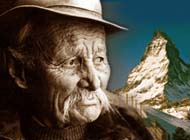Zermatt marks a special birthday

The resort of Zermatt has been celebrating the 100th birthday of one its most famous citizens.
Ulrich Inderbinen spent 70 years working as a mountain guide. His life is a testimony to just how much this corner of Switzerland has changed over a century.
When Inderbinen was born, on December 3 1900, Zermatt was a poor farming village of 740 people. The road to the village was open only in summer. The first doctor arrived only in 1909, and it wasn’t until 1930 that the train began coming to Zermatt all year round.
Ulrich Inderbinen’s parents were mountain farmers. It was a large family; Ulrich had two brothers and six sisters. The Inderbinens spent summers up on the mountain pastures, and winters down in the village of Zermatt. At the age of five Ulrich had his first job; as a cowherd.
“It was a hard life,” Inderbinen remembers. “We were very poor, the whole village was poor. But it was a good, simple life. Everyone knew everyone else and we helped one another. That’s gone now, Zermatt has grown too big.”
Mountaineering was a way of life for the people of Zermatt too. In 1921 Inderbinen climbed the Matterhorn for the first time, together with his sister. Four years later he qualified as a professional mountain guide.
But although the Matterhorn was already becoming famous with foreign climbers, during the 1920’s and 30’s not enough tourists made the trip to Zermatt to allow him to make a living.
“There were simply too many guides and not enough visitors,” says Inderbinen. “We used to wait outside the train station in the hope of getting clients, but in the end the village council passed a law forbidding us from doing that. They didn’t want us pestering the tourists.”
He worked as a carpenter, and as a labourer during this time, but found it difficult to make ends meet. Although he met his wife Anna in 1928, the couple could not afford to marry until 1933. Their wedding took place early in the morning, as was common then, so that bride and groom could still get to work on time.
During the 1930’s Inderbinen began to get work as a ski tour guide taking guests up on to the Breithorn. Equipment was rudimentary: instead of the modern fur or felt to stick to the bottom of the skis for the upward climb, string and rope were wrapped around them.
The Second World War put an end to Zermatt’s growing tourism industry, and Inderbinen, like many of his friends in the village, spent the war guarding Switzerland’s border with Italy. Well into the 1950’s there was no work for mountain guides, and unemployed guides like Inderbinen who had completed their military service received pensions from the state.
Only in 1960 did tourism really take off again in Zermatt, and Inderbinen found himself busy when most men would have been thinking about retiring. But not every visitor to Zermatt wanted to climb the Matterhorn with a man who should have been drawing his old age pension.
One young German climber at first refused to climb with Inderbinen, saying, “I’m not going up with that old man, I’ll end up having to carry him.” A day later, the same man staggered down the mountain again, claiming that Inderbinen’s hiking speed had worn him out. “Perhaps you should get an older guide next time,” joked Inderbinen.
In fact Inderbinen worked as a mountain guide until he was well into his 80’s, and for a while he enjoyed the title of “the world’s oldest mountain guide”. He also continued to climb for pleasure. In 1984 he climbed Mont Blanc in France, in 1990 he stood on the summit of the Matterhorn for the last time, and in 1996 he climbed the Breithorn.
During all his years as a guide Inderbinen continued to live a simple life. He never got a telephone: guests who wanted to contact him were told he could be found most evenings in the village square outside the church.
Inderbinen’s climbing days are now over. “I prefer to stay down here in the village where it’s warm,” he says. “But I get up every morning at half past six at the latest, I go to early mass at eight, and then I might go shopping or to the post office. In the afternoon I have a little rest in my chair. After all, what else is an old man supposed to do?”
During Inderbinen’s lifetime Zermatt has changed beyond recognition. The poor mountain village has become a fashionable resort, and the simple wooden houses of the Valais farmers have been replaced by five storey chalet style hotels. Souvenir shops selling cowbells and watches line the main street, and the restaurants offer menus in Japanese.
What hasn’t changed though, is the mountain Inderbinen has climbed over 370 times. The Matterhorn still rises majestically above the village, and it remains, for Inderbinen and everyone else who loves it, “far and wide, the most beautiful and fascinating mountain of them all”.
by Imogen Foulkes

In compliance with the JTI standards
More: SWI swissinfo.ch certified by the Journalism Trust Initiative
You can find an overview of ongoing debates with our journalists here . Please join us!
If you want to start a conversation about a topic raised in this article or want to report factual errors, email us at english@swissinfo.ch.